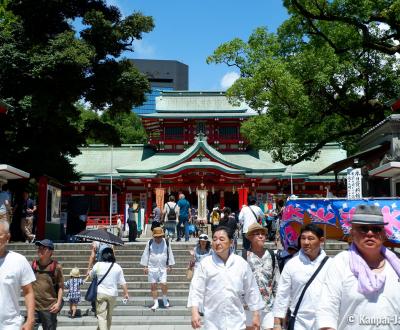Tomioka Hachiman-gu
Tokyo’s Prominent Shrine Forsaken by Tourists
Tomioka Hachiman-gu is a Shinto shrine in Koto ward, at the east of downtown Tokyo. Dedicated to the god of war Hachiman, it was enlisted in the "10 Tokyo shrines" designated by the Meiji government. As a landmark of sumo traditional wrestling, it hosts one of the biggest matsuri of the capital every year in a friendly and plebeian atmosphere.
Tomioka Hachiman-gu is Tokyo’s largest shrine dedicated to the god of war Hachiman. One of the most important clan of the early Japanese Middle Ages, the Minamoto, had made it their tutelary deity. Willing to win the god’s favors, the Tokugawa shogun had this shrine build in 1627 and Hachiman became the guardian deity of his new dynasty, who reigned during the whole Edo period (1603-1868).
A classical Shinto place of worship
The main entrance is marked by the tall red torii ⛩️ gate, contrasting with the clear colored tiles of the road. The main path is bordered by elegant poles, which are surmounted of lanterns 🏮 ornamented with the shrine’s crest. The ablution fountain, that one must visit before the main hall, is decorated by two phoenixes spewing water. The golden birds’ motif is quite unusual, as such fountain are usually decorated with a dragon.
The main hall Honden stands at the end of the path. The current buildings dates back to 1956 and was constructed in the Hachiman-zukuri, a traditional shrine architectural style, characterized by parallel roofs. The roofs were covered with copper, that became green over time and now offer a beautiful contrast with the supporting structure’s glowing red.

Several curiosities are sheltered in the shrine’s compound:
- The statue of Ino Tadataka (1745-1818), who walked Japan for 17 years to draw the country’s first map. He lived nearby and came here to pray before each cartography journey.
- The exhibition hall of the two mikoshi, Ichinomiya and Ninomiya, the portable shrines used during the festivals, glowing with their gilding and precious stones.
- A small Shiryokan museum (booking required) displaying items, pictures and etchings related to the shrine’s history and its iconic festival.
- A monument dedicated to the sumo wrestlers: Yokozuna Rikishi-hi.
On the side, a peaceful park shelters a pond with koi carps, a handful of lanterns and torii to highlight a small shrine dedicated to Inari, Nanawatari-jinja, that reminds of the deity worshiped here before Hachiman.
Sumo wrestling amateurs’ pilgrimage
Tomioka Hachiman-gu shrine is indeed strongly connected to the Japanese traditional wrestlers, the sumo, also called rikishi. The Kanjin-zumo, the predecessor the Japanese Sumo Association that organizes all the Japanese wrestling tournaments, was created here. From 1684 and for 100 years, two tournaments per year were authorized by the shogunate in Tomioka Hachiman-gu.
In 1900, Jinmaku Kyugoro, who was the twelfth Yokozuna (the highest rank for a rikishi), had a 3-meter-high stele erected as a tribute to his predecessors: the Yokozuna Rikishi-hi. Each new Yokozuna had his name engraved on the stone monument ever since. The shrine is therefore a small pilgrimage site for those who love the sacred sport. They can even admire the wrestlers’ hand prints and footprints casts and recognize their extraordinary dimensions.
The wrestlers are so important that they open the Setsubun rituals with the throwing beans mamemaki ceremony. The beans collected at this occasion are renowned for bringing luck.

Shitamachi’s plebeian shrine
Tomioka Hachiman-gu is in Shitamachi, the former lower part of Edo city, and kept some of its popular aspects. Several times a month, are hold in its grounds:
- An antique market, almost every Sunday, for ancient objects, toys and books.
- A flea market (on the 15th and the 28th) dedicated to the daily items and housewares.
Lastly, the shrine is renowned for its great yearly festival: Fukagawa Hachiman Matsuri in mid-August. It is the occasion for an impressive mikoshi procession. The Ichinomiya shrine, the most important of the celebration, weights more than 4 tons and is the biggest of Japan. One of the characteristics of this event is the friendly and joyful atmosphere, and the gathering of participants of all-ages to sprinkle water on the float carriers during the parade. A must-see event for anyone in Tokyo at this time of the year.

